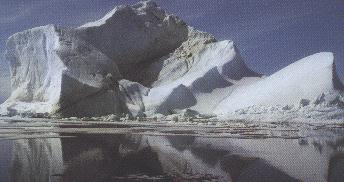
Icebergs
Whenever glaciers or ice sheets reach the sea, the
movement of the ice eventually pushes the end of the sheet into water
which is deeper than the thickness of the glacier ice. Portions of
the end of the glacier break off and form floating masses known as
icebergs or bergs. Icebergs are often of enormous size and may reach
a height of 90 to 150 m (about 300 to 500 ft) above the surface of
the sea. Yet about 90 percent of the mass of an iceberg is
beneath the surface . Icebergs are common
in both the Arctic and Antarctic regions and are often carried into
lower latitudes by sea currents, particularly in the North Atlantic
Ocean. North Atlantic icebergs all come from the Great Greenland ice
sheet and have been observed as far as 3200 km (about 2000 mi) from
their origin. After the sinking (1912) of the steamship Titanic, 16
nations instituted an iceberg patrol of the North Atlantic, which
included the U.S. Coast Guard. Now known as the
International Ice patrol , it tracks
icebergs and reports their location to ships.
Back to summary
Back to Main
Visit this great site for more iceberg info
Greenland
Iceberg Paradise